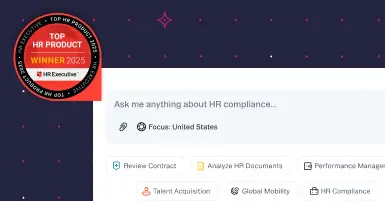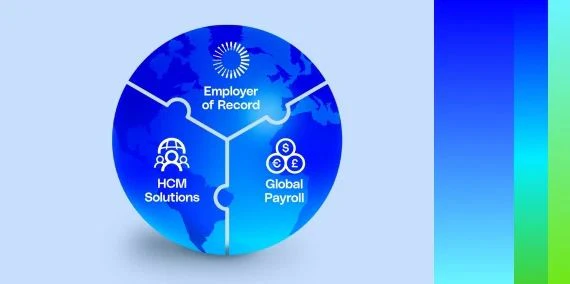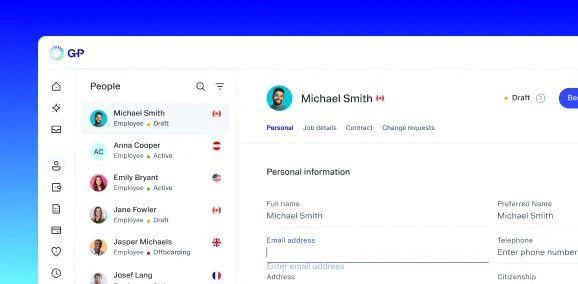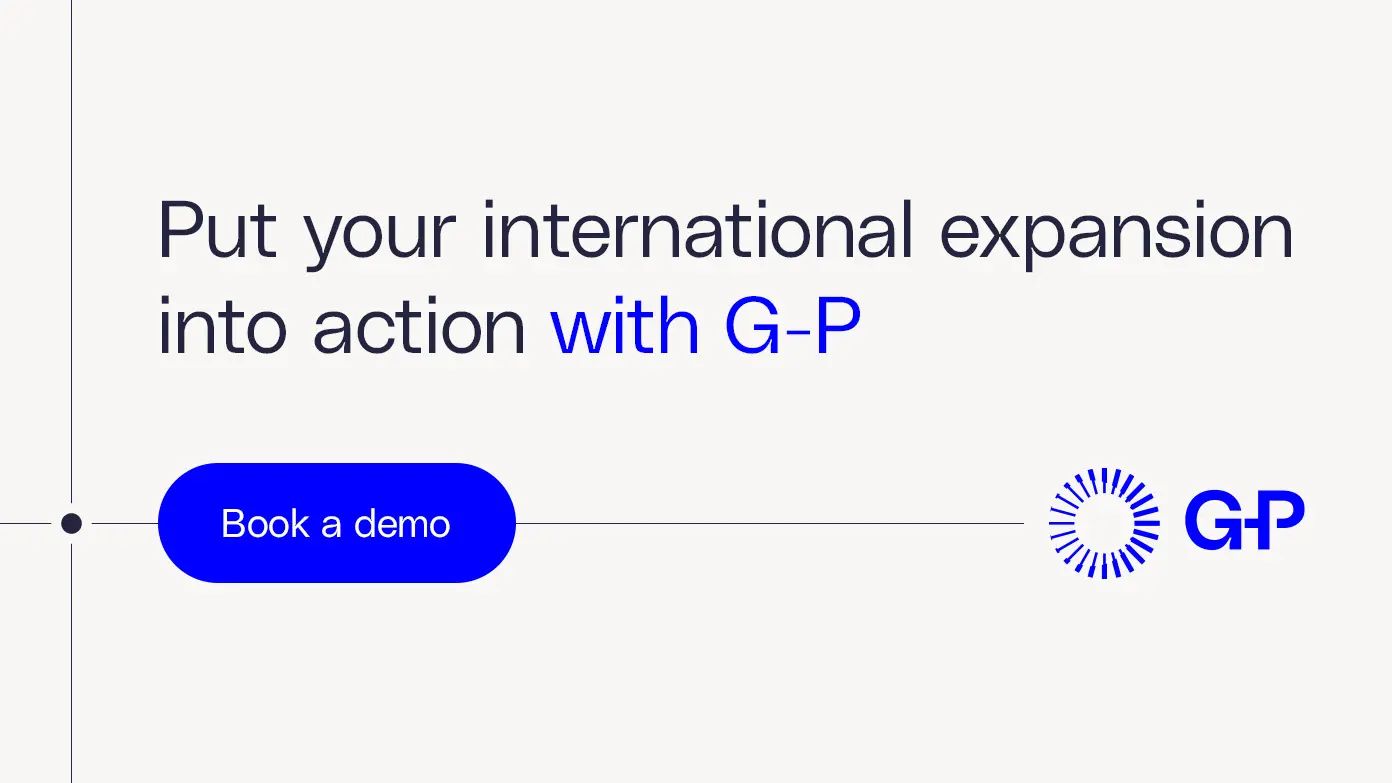Expanding your business internationally is essential to stay competitive. According to the 2025 World at Work report, 67% of executives are prioritizing growth over the next year (an increase of 7% from 2024).
Success in global markets takes more than ambition. You need a clear international expansion strategy that addresses everything from compliance challenges to talent acquisition best practices. With the right approach and tools, you can make global employment your competitive edge.
What is a global expansion strategy?
A global expansion strategy is your roadmap for entering and operating in international markets. It's a structured plan that guides how you'll navigate different regulatory environments, manage global teams, and adapt your operations across borders.
Your market expansion strategy should address these questions:
-
Which markets offer the best opportunities for your products or services?
-
What are the local employment laws, tax regulations, and cultural expectations?
-
Do you have a scalable approach to hiring and managing international talent?
According to the International Labour Organization, the percentage of individuals who want to work but don't have a job has shrunk from 16% in 2004 to 9% in 2024. More people worldwide are employed, increasing competition for the best candidates.
Global business expansion strategies need technology to turn vision into action. An AI-powered global HR agent like G-P Gia™ can:
-
Advise on the HR, legal, and compliance requirements for hiring employees or contractors in new countries.
-
Give you up-to-date information on employment laws, mandatory benefits, payroll requirements, and local labor practices in your target markets.
-
Guide you on best practices for competitive compensation and benefits packages.
-
Advise on visa, work permit, and relocation requirements for moving talent across borders.
-
Review documents for compliance, and even translate documents into other languages instantly.
Gia makes international expansion more accessible to businesses of all sizes.
Steps for building an international expansion strategy
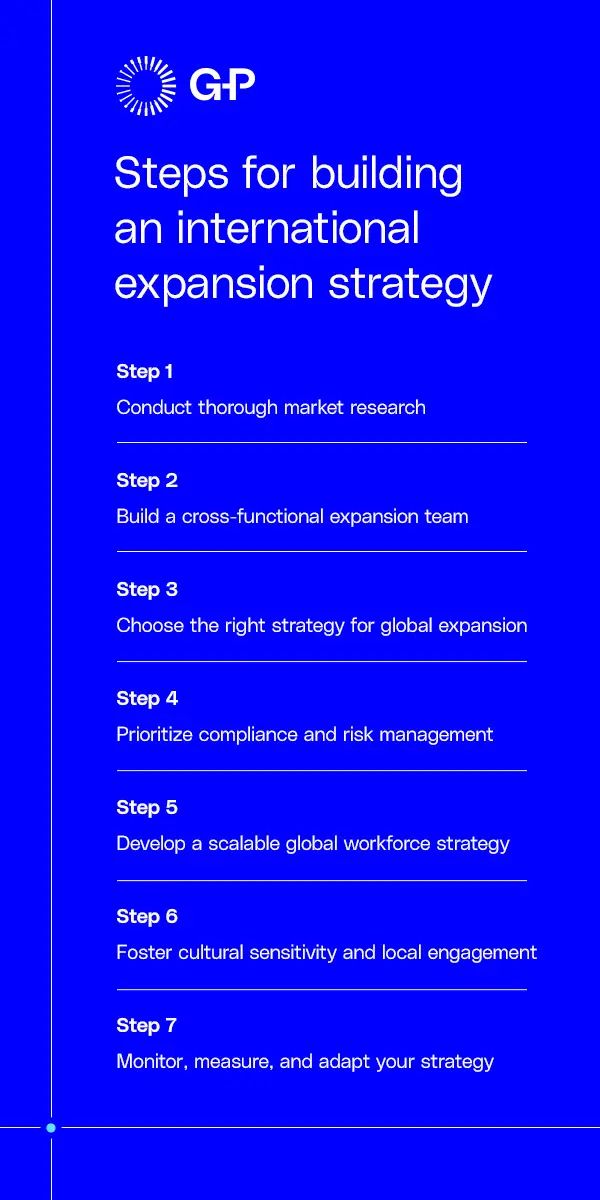
Here's how to build a framework that sets you up for success:
Step 1: Conduct thorough market research
Before you expand your business globally, you need insights about your target markets. Look at economic indicators to analyze market size, growth potential, and competitive landscapes.
Use market intelligence resources to analyze consumer behavior patterns and identify emerging trends. Research local purchasing power, digital infrastructure, and regulatory environments that could impact your operations.
Step 2: Build a cross-functional expansion team
A successful market expansion strategy involves more than just HR. Include experts from finance, legal, operations, and sales. When expanding globally, you'll need to solve problems you haven't faced before. Each department brings knowledge that's critical for international success. Look for people who have worked with international partners or have experience in your target markets.
Create clear roles and appoint a dedicated expansion lead. They'll coordinate across departments and keep everyone focused on your goals. This person should be able to make informed decisions when opportunities or challenges arise.
If you lack internal expertise, consider partnering with an employer of record (EOR). EORs manage the entire employment lifecycle and have in-country experts all over the world to ensure smooth operations. Working with an EOR frees your internal teams from the administrative burden of global expansion, so they can focus on strategic initiatives.
Step 3: Choose the right strategy for global expansion
You can expand your business globally using four main approaches. The option you should use to expand internationally depends on your budget, timeline, and risk tolerance. Expansion strategies include:
-
EOR services: G-P EOR lets you hire in 180+ countries, without setting up a legal entity. You can test new markets with minimal investment and scale based on results.
-
Subsidiaries: Setting up subsidiaries gives you complete control but requires significant time and money. You'll need to navigate local incorporation laws and find or build office space. This is a good option if you're committed to a market long-term and need a strong local presence.
-
Partnerships: Joint ventures and partnerships let you share risks and costs with local companies. Success depends on finding partners whose goals align with yours.
-
Franchising: Franchising or licensing works when your business model is proven and repeatable. Local operators run the business while you provide the brand, systems, and support. This approach can scale quickly, but it needs strong quality control systems.
Step 4: Prioritize compliance and risk management
Every country has different employment laws, tax codes, and business regulations. What's standard practice in one country might be illegal in another. Build compliance into your international expansion process from the start. Create checklists for each country covering hiring, onboarding, payroll, and termination procedures. Document everything to show you're following regulations.
Technology can help you manage compliance. Use AI to track regulation changes automatically and stay updated on new requirements. Gia is agentic AI that can review and update employment contracts for compliance in multiple jurisdictions. Reduce manual errors and save up to 95% of the time and costs of global compliance.
Don't try to handle everything internally. EOR services with compliance teams understand local nuances you may miss and can help you avoid common mistakes.
Consider political and economic risks, too. Trade policies change, currencies fluctuate, and political instability can disrupt operations. Build contingency plans for different scenarios and diversify across markets to reduce concentration risk.
Step 5: Develop a scalable global workforce strategy
Your global workforce strategy determines how you'll attract, manage, and retain international talent. It should include:
-
Employer value proposition: What makes your company attractive to global candidates? Maybe it's career development opportunities, innovative projects, or flexible work arrangements. Understand what matters most to candidates in each market.
-
Company policies: Create consistent core policies while allowing local flexibility. Your code of conduct and performance standards should apply everywhere. But work schedules, holiday calendars, and benefits packages need local adaptation. Find the right balance between global consistency and regional relevance.
-
Employment types: Contractor and employee definitions vary by country, but many laws focus on the degree of independence and business integration. Adapt your contracts to local classification criteria to maintain compliance and operational efficiency.
-
Career progression: How do global employees advance within your organization? Can they transfer between countries or departments? Would they need visa sponsorship at certain career levels? Clear career paths help you retain top talent and build a strong global culture.
-
Technology: Choose tools that work well across different internet speeds and devices. Set up training sessions so everyone uses them effectively. Consider time zones when scheduling meetings and record important sessions so people in other regions can access them.
-
Manager training: Leading remote, multicultural teams requires unique skills. Managers must understand cultural communication styles, build trust without daily interaction, and ensure fair treatment across regions.
Step 6: Foster cultural sensitivity and local engagement
Cultural adaptation goes beyond translation. Familiarize yourself with local business practices, communication styles, and employee expectations. What motivates workers in one country might not resonate in another.
Invest in cultural training for your expansion team and managers. Create feedback mechanisms that let local employees share insights about market conditions and cultural nuances. This ground-level intelligence is often more valuable than formal market research.
Remember that cultural sensitivity extends to your technology choices, too. Make sure HR systems and communication tools work in all target markets, considering factors like internet connectivity and device preferences.

Step 7: Monitor, measure, and adapt your strategy
Your global expansion strategy needs constant refinement based on real results. To make sure it keeps serving you, do the following:
-
Define KPIs. These might include time-to-hire, employee retention rates, revenue per employee, or market penetration. Track leading indicators that predict future success and lagging indicators that confirm results.
-
Create a dashboard that shows performance across markets. You'll be able to spot trends and identify problems early. If hiring takes longer in certain countries, find out why. If retention is lower in specific regions, understand the causes.
-
Schedule regular strategy reviews. Monthly operational reviews keep tactics on track, while quarterly reviews assess overall progress. Annual strategic reviews consider major changes or new market entries.
-
Listen to feedback from local teams. They see opportunities and challenges first. Create formal channels for input while encouraging informal feedback through regular check-ins and open communication.
-
Stay informed about external changes. New regulations, economic shifts, and competitive moves all affect your strategy. Build flexibility to respond fast when conditions change.
-
Be willing to pivot when necessary. Sometimes, markets don't develop as expected. Regulations might become too restrictive, or competition might be stronger than anticipated. Recognize when to adjust your approach or exit a market.
Why global expansion strategies matter
An effective global expansion strategy provides many benefits beyond accessing new customers. You're positioning your company for long-term resilience and growth.
Market diversification reduces your vulnerability to regional economic downturns. When one market faces challenges, others can maintain stability.
Diverse teams have high innovation potential. Different perspectives spark creativity and help you develop products and services that resonate globally. Companies with an international presence often report increased innovation and faster problem-solving.
What are the benefits of international expansion?
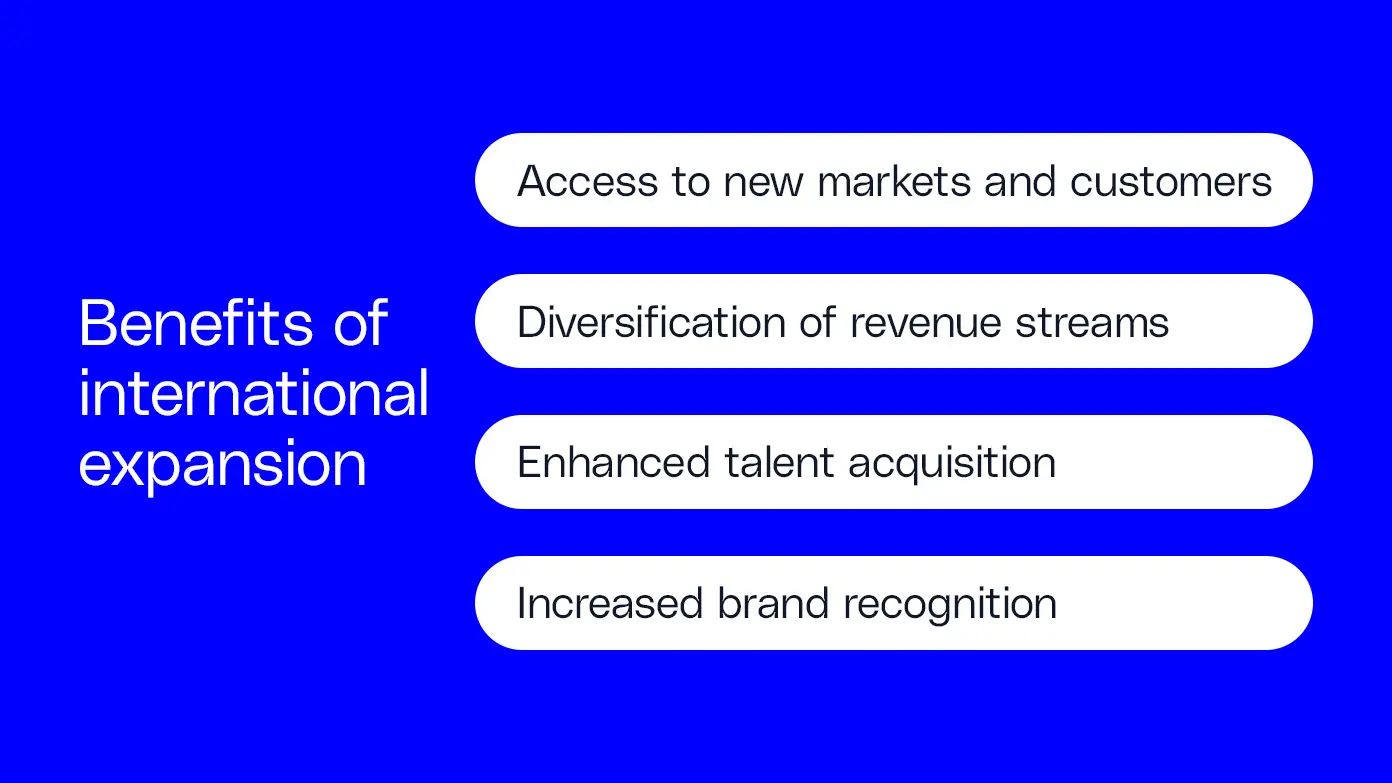
The benefits of international expansion include:
-
Access to new markets and customers: Global expansion boosts your revenue potential by exposing you to new markets. You'll also discover new applications for your products and services.
-
Diversification of revenue streams: Currency fluctuations, seasonal variations, and economic cycles affect markets differently. By operating globally, you create more revenue patterns. This stability makes your company more attractive to investors and partners.
-
Enhanced talent acquisition: Global talent access lets you build teams with specialized skills and diverse expertise. You're no longer limited by local talent shortages or skills gaps.
-
Increased brand recognition: International presence enhances credibility with customers, partners, and investors. It signals that you've achieved the scale and expertise to successfully operate across borders. This reputation opens doors to new partnerships and opportunities.
What are the challenges of developing strategies for international expansion?
As you prepare your international expansion strategy, keep an eye out for the following challenges:
-
Regulatory complexity: Employment laws, tax codes, and business regulations vary between countries. It can be difficult to keep track of everything as you expand. An AI-powered HR agent like Gia helps you stay current with changes and navigate compliance complexities with ease.
-
Talent acquisition and retention: Competition for skilled workers can be tough. Creating compensation packages tailored to local needs can make it easier to attract and retain top talent.
-
Cultural and operational hurdles: Communication across time zones, language barriers, and different work styles create friction if not addressed early. Accounting for cultural differences, using collaboration platforms, and outlining nonnegotiable aspects of your company culture can ease these challenges.
Put your international expansion into action with G-P™
As the recognized leader in global employment, G-P helps companies of all sizes hire, onboard, and manage global teams in 180+ countries, regardless of entity status. Our AI-powered global employment products and EOR solutions are backed by the largest team of in-country HR, legal, and compliance experts to streamline and simplify the entire global employment lifecycle.
Accelerate your global expansion. Contact us today.


